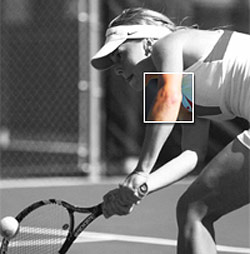Pain on Outside of Elbow
Get Help With Pain on Outside of ElbowPain on the outside of the elbow which is referred to as lateral epicondylitis can be disabling. Typically seen in 30-60 year olds, patients complain of point tenderness over the outside aspect of the elbow ( lateral epicondyle) aggravated by gripping and activities that extend the wrist.
The pain is thought to arise from degenerative changes in the muscles that attach to lateral epicondyle called the extensor muscles. These muscles allow the arm to extend(bent backward) .
The diagnosis is made by clinical signs and symptoms. A common diagnostic test is the Cozen test. Conservative treatment includes PT, NSAIDs, heat, ice and rest. Injection of cortisone has been demonstrated to be no different than placebo. Complications from repeated steroid injections include fat atrophy and potential weaking of the tendon.
Not all lateral elbow pain is lateral epicondylitis.
LF presented with a 5 month history of lateral elbow pain after tripping over her dog and striking her elbow on her granite countertop. Conservative therapy had failed and her physician had referred her for PRP injection. At the Centeno-Schultz Clinic therapeutic injections are performed with either x-ray or ultrasound to confirm accurate placement. LF’s ultrasound exam was significant for tendosis (tendosis) of the extensor muscles which are commonly associated with lateral epicondylitis. More important was the significant tendosis and partial muscle tear of the triceps muscle (not typically seen with lateral epiconduylitis). Identifying this second site of injury was cardinal as it represented another source of pain which needed to be treated for maximal clinical outcome. At the Centeno-Schultz Clinic an accurate diagnosis and appropriate placement of regenerative therapies whether it be stem cell therapy, prolotherapy, APC or PRP injections is our standard.
Golfer’s Elbow
Golfer’s elbow involves tears in the ulnar collateral ligament and pain or soreness on the inside of the elbow. The bony bump you feel there is the medial epicondyle of the humerus (upper arm bone). There are five forearm muscles that attach at this point, all of which are involved in helping to flex or rotate the forearm and wrist. Pain can get worse when you throw a ball, grip a dumbbell, turn a screwdriver, and other movements that involve the fingers, hand, wrist, and/or elbow. Tennis elbow is similar, however, it refers to the outside of the elbow, at the lateral epicondyle.
Read More About Golfer’s ElbowLateral Epicondylitis / Tennis Elbow
Lateral epicondylitis otherwise known as tennis elbow is an overuse injury involving the extensor muscles that originate on the bony prominence (epicondyle) on the outside (lateral) aspect of the elbow. It is more properly termed tendinosis that specifically involves the origin of the extensor carpi radialis brevis muscle. In a study, Nirschl and Pettrone attributed the cause of lateral epicondylitis to be tearing in the origin of the extensor carpi radialis brevis (ECRB) muscle (1). The extensor carpi radialis brevis (ECRB) muscle originates from the lateral epicondyle. It functions to move the wrist so that the hand moves away from the palm and towards the thumb.
Read More About Lateral Epicondylitis / Tennis Elbow
